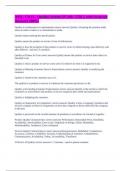ASQ - Ch 11 - Quality System (P. 260 - 278) || with Accurate
Answers 100%.
Quality as conformance to requirements correct answers Quality is keeping the promise made
when an order is taken or a commitment is made.
Quality means meeting the specifications.
Quality means the product or service is free of deficiencies.
Quality is how the recipient of the product or service views it: before buying, upon delivery, and
after delivery - and use, if a product.
Quality as Fitness for Use correct answers Quality means the product or service does what it is
intended to do.
Quality is what a product or service costs users if it doesn't do what it is supposed to do.
Quality as Meeting Customer Service Expectations correct answers Quality is satisfying the
customer.
Quality is whatever the customer says it is.
The quality in a product or service is whatever the customer perceives it to be.
Quality as Exceeding Customer Expectations correct answers Quality is the extent to which the
customers or users believe the product or service surpasses their needs and expectations.
Quality is delighting the customer.
Quality as Superiority to Competitors correct answers Quality is how a company's products and
services compare to those of competitors or how they compare to those offered by the company
in the past.
Quality is perceived as the overall measure of goodness or excellence of a brand or supplier.
Product Quality Characteristics correct answers Performance, Reasonable Price, Durability,
Availability, Serviceability, Ease of use, Simplicity of design, Safety, Reliability,
Maintainability, Aesthetics, Ease of disposal
Service Quality Characteristics correct answers Responsiveness, Reliability, Competence,
Accuracy, Courtesy, Credibility, Security, Understanding of customer, Completeness,
Communication, Availability, Safety, Accessibility, Timeliness
5 Driver's of Quality correct answers 1. Customer - need to please customer
, 2. Product/Services - producing defect-free (links to customer driven but focus is on the quality
of the product/service (supporting ISO-9001-based quality management system).
3. Employee Satisfaction
4. Organizational Force - total quality or segmented approach to quality implementation
5. Competitors
Quality of Design vs. Quality of Conformance correct answers These are two different meanings
of quality, both valid in most situations.
Quality of design is the designed-in quality, such as the grade of material used to assemble a
shirt, or to upholster a car seat. Quality of design increases customer satisfaction, and usually
costs more. Designing for quality instead of inspecting it.
Quality of conformance is the extent to which the product conforms to its specification, such as
sizing, stitching, number and consistency of buttons, etc. It decreases customer dissatisfaction,
and usually costs less.
Organization's aim to not only meet customer's requirements but exceed them, when possible
(design for Six Sigma - DFSS).
Little q an Big Q correct answers Organizations focusing on quality control & inspection
activities (little q) will fail to see that to be fully effective, they must transform their thinking to
quality across the organization (Big Q)
Quality Function Mission correct answers For most quality functions, the mission includes
common elements to ensure that:
-customer focus and quality are part of the organization's mission
-all suppliers understand fundamental principles of quality
-all suppliers understand fundamental principles of quality
- all employees understand fundamental principals of quality & how to apply them
-all employees master the quality tools needed to carry out their mission within the organization.
Quality Function Mission correct answers Quality Function mission is both derived from and an
input into the organization's mission. Upward & downward organizational collaboration is
essential in quality planning. A quality function mission can be developed in several successive
steps:
1. Identify one particular service or product provided by the quality function.
2. Determine the customer(s) of that service or product.
3. Discuss with the customer(s) whether they need this service or product. What attributes are
valuable? Which are not valuable (e.g., speed, accuracy, schedule, packaging or formatting).
4. If a need exists, agree on the standard and measures applicable. if the service or product is not
needed, eliminate it.
5. Qualify the gap between current practice and customer needs.
6. Define the actions for improvement of that particular service or product on the basis of
resources and relative priorities.




